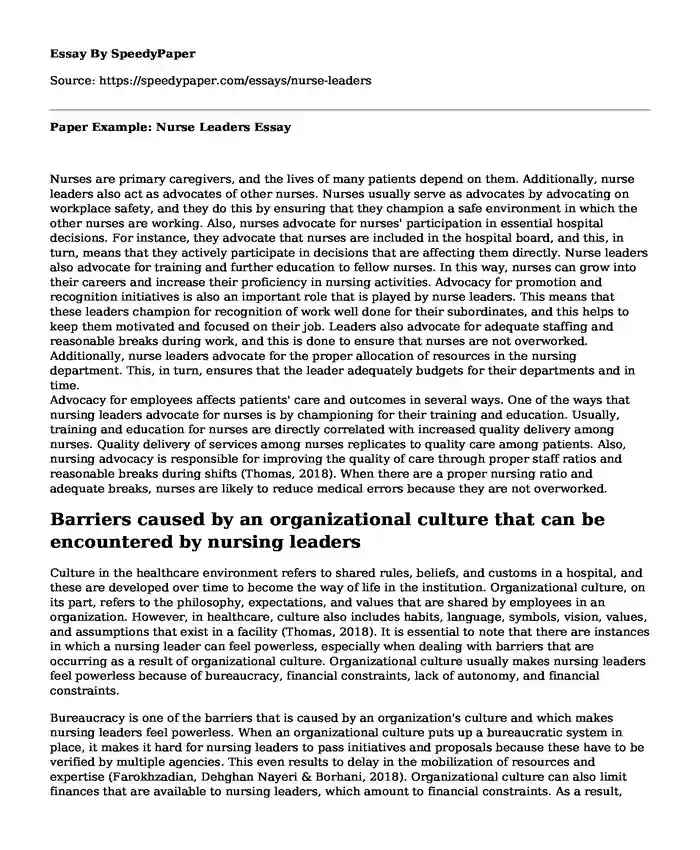
| Type of paper: | Article |
| Categories: | Nursing management Organizational culture Nursing leadership |
| Pages: | 3 |
| Wordcount: | 674 words |
Nurses are primary caregivers, and the lives of many patients depend on them. Additionally, nurse leaders also act as advocates of other nurses. Nurses usually serve as advocates by advocating on workplace safety, and they do this by ensuring that they champion a safe environment in which the other nurses are working. Also, nurses advocate for nurses' participation in essential hospital decisions. For instance, they advocate that nurses are included in the hospital board, and this, in turn, means that they actively participate in decisions that are affecting them directly. Nurse leaders also advocate for training and further education to fellow nurses. In this way, nurses can grow into their careers and increase their proficiency in nursing activities. Advocacy for promotion and recognition initiatives is also an important role that is played by nurse leaders. This means that these leaders champion for recognition of work well done for their subordinates, and this helps to keep them motivated and focused on their job. Leaders also advocate for adequate staffing and reasonable breaks during work, and this is done to ensure that nurses are not overworked. Additionally, nurse leaders advocate for the proper allocation of resources in the nursing department. This, in turn, ensures that the leader adequately budgets for their departments and in time.
Advocacy for employees affects patients' care and outcomes in several ways. One of the ways that nursing leaders advocate for nurses is by championing for their training and education. Usually, training and education for nurses are directly correlated with increased quality delivery among nurses. Quality delivery of services among nurses replicates to quality care among patients. Also, nursing advocacy is responsible for improving the quality of care through proper staff ratios and reasonable breaks during shifts (Thomas, 2018). When there are a proper nursing ratio and adequate breaks, nurses are likely to reduce medical errors because they are not overworked.
Barriers caused by an organizational culture that can be encountered by nursing leaders
Culture in the healthcare environment refers to shared rules, beliefs, and customs in a hospital, and these are developed over time to become the way of life in the institution. Organizational culture, on its part, refers to the philosophy, expectations, and values that are shared by employees in an organization. However, in healthcare, culture also includes habits, language, symbols, vision, values, and assumptions that exist in a facility (Thomas, 2018). It is essential to note that there are instances in which a nursing leader can feel powerless, especially when dealing with barriers that are occurring as a result of organizational culture. Organizational culture usually makes nursing leaders feel powerless because of bureaucracy, financial constraints, lack of autonomy, and financial constraints.
Bureaucracy is one of the barriers that is caused by an organization's culture and which makes nursing leaders feel powerless. When an organizational culture puts up a bureaucratic system in place, it makes it hard for nursing leaders to pass initiatives and proposals because these have to be verified by multiple agencies. This even results to delay in the mobilization of resources and expertise (Farokhzadian, Dehghan Nayeri & Borhani, 2018). Organizational culture can also limit finances that are available to nursing leaders, which amount to financial constraints. As a result, these leaders are unable to mobilize and channel finances to their departments to better nursing. In other instances, an organization's culture might limit the workforce that is available to a nursing leader, and this might lead to technical constraints. Technical constraints are responsible for limiting the ability of a nursing leader to mobilize expertise. It is also possible that ban organizational culture might lender nursing leaders to be powerless by rendering them incapable of deciding on priorities. Consequently, this bars them from displaying their role at best.
References
Farokhzadian, J., Dehghan Nayeri, N., & Borhani, F. (2018). The long way ahead to Achieve an effective patient safety culture: challenges perceived by Nurses. BMC Health Services Research, 18(1). doi: 10.1186/s12913-018-3467-1
Thomas, J. (2018). Nursing Leadership & Management: Leading and Serving. Retrieved 11 April 2020, from https://lc.gcumedia.com/nrs451vn/nursing-leadership-and-management-leading-and-serving/v1.1/#/chapter/4
Cite this page
Paper Example: Nurse Leaders. (2023, May 17). Retrieved from https://speedypaper.com/essays/nurse-leaders
Request Removal
If you are the original author of this essay and no longer wish to have it published on the SpeedyPaper website, please click below to request its removal:
- Essay Sample on Diversity and Cultural Competence
- Essay Example about Quality Patient Care
- Essay Example Dedicated to Evidence-Based Practice in Diabetes
- The Gap in E-commerce - Free Essay
- Free Essay on Influence of Politics and Power in Delta Dental
- Essay Example: Leveraging Informatics in the Health Sector
- Paper Sample on Changing Organizational Culture
Popular categories




